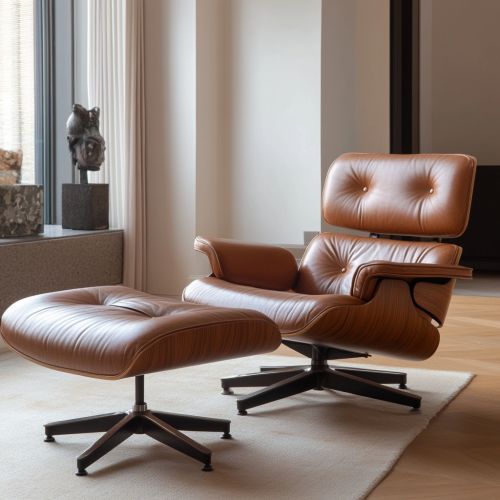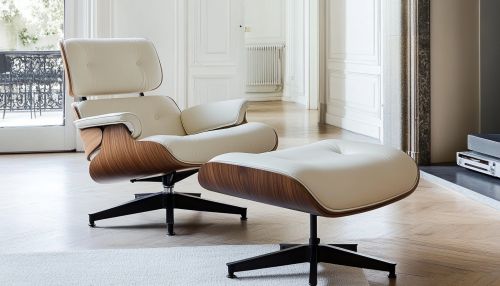Charles and Ray Eames: Difference between revisions
(Created page with "== Early Life and Background == Charles Eames was born on June 17, 1907, in St. Louis, Missouri. He developed an early interest in engineering and architecture, which led him to study architecture at Washington University in St. Louis. However, he left the university after two years due to disagreements with the faculty over his modernist ideas. Ray Eames, born Bernice Alexandra Kaiser on December 15, 1912, in Sacramento, California, pursued painting and design. She stu...") |
No edit summary |
||
| Line 17: | Line 17: | ||
One of the most significant contributions of Charles and Ray Eames was in the field of furniture design. Their innovative use of materials such as molded plywood and fiberglass revolutionized the industry. The [[Eames Lounge Chair]] and Ottoman, introduced in 1956, remains a classic example of their work, combining luxury with comfort. Another notable piece is the Eames Molded Plastic Chair, which was one of the first mass-produced plastic chairs. | One of the most significant contributions of Charles and Ray Eames was in the field of furniture design. Their innovative use of materials such as molded plywood and fiberglass revolutionized the industry. The [[Eames Lounge Chair]] and Ottoman, introduced in 1956, remains a classic example of their work, combining luxury with comfort. Another notable piece is the Eames Molded Plastic Chair, which was one of the first mass-produced plastic chairs. | ||
[[Image:Detail-98473.jpg|thumb|center|Eames Lounge Chair and Ottoman in a modern living room setting.|class=only_on_mobile]] | |||
[[Image:Detail-98474.jpg|thumb|center|Eames Lounge Chair and Ottoman in a modern living room setting.|class=only_on_desktop]] | |||
=== Architecture === | === Architecture === | ||
Latest revision as of 03:30, 15 October 2024
Early Life and Background
Charles Eames was born on June 17, 1907, in St. Louis, Missouri. He developed an early interest in engineering and architecture, which led him to study architecture at Washington University in St. Louis. However, he left the university after two years due to disagreements with the faculty over his modernist ideas. Ray Eames, born Bernice Alexandra Kaiser on December 15, 1912, in Sacramento, California, pursued painting and design. She studied at the Bennett School for Girls in Millbrook, New York, and later at the Cranbrook Academy of Art in Michigan, where she met Charles.
Partnership and Marriage
Charles and Ray Eames married in 1941, forming a partnership that would become one of the most influential in the field of design. Their collaboration was marked by a shared vision of integrating art and technology to create functional yet aesthetically pleasing designs. Together, they explored various mediums, including architecture, furniture design, industrial design, and film.
Design Philosophy
The Eameses believed in the principle of "design as a way of life," emphasizing the importance of functionality and accessibility in their work. They were proponents of the modernist movement, which sought to break away from traditional design forms and embrace new materials and technologies. Their philosophy was rooted in the idea that design should improve the quality of life for everyone, not just the elite.
Iconic Works
Furniture Design
One of the most significant contributions of Charles and Ray Eames was in the field of furniture design. Their innovative use of materials such as molded plywood and fiberglass revolutionized the industry. The Eames Lounge Chair and Ottoman, introduced in 1956, remains a classic example of their work, combining luxury with comfort. Another notable piece is the Eames Molded Plastic Chair, which was one of the first mass-produced plastic chairs.


Architecture
The Eames House, also known as Case Study House No. 8, is a landmark of mid-20th-century modern architecture. Built in 1949 in Pacific Palisades, California, the house was part of the Case Study House Program, which aimed to create affordable and efficient housing using industrial materials. The design of the Eames House reflects the couple's philosophy of integrating the indoor and outdoor environments, with large glass windows and open spaces.
Film and Multimedia
Charles and Ray Eames were pioneers in the use of film and multimedia as tools for education and communication. Their short film "Powers of Ten" (1977) is a notable example, illustrating the relative scale of the universe in factors of ten. The Eameses produced over 125 films, covering a wide range of subjects from mathematics to the design process itself.
Influence and Legacy
The impact of Charles and Ray Eames on the field of design is profound. Their work has influenced generations of designers and architects, and their designs continue to be celebrated for their timeless quality. The Eameses' approach to problem-solving and their commitment to improving everyday life through design have left a lasting legacy.
